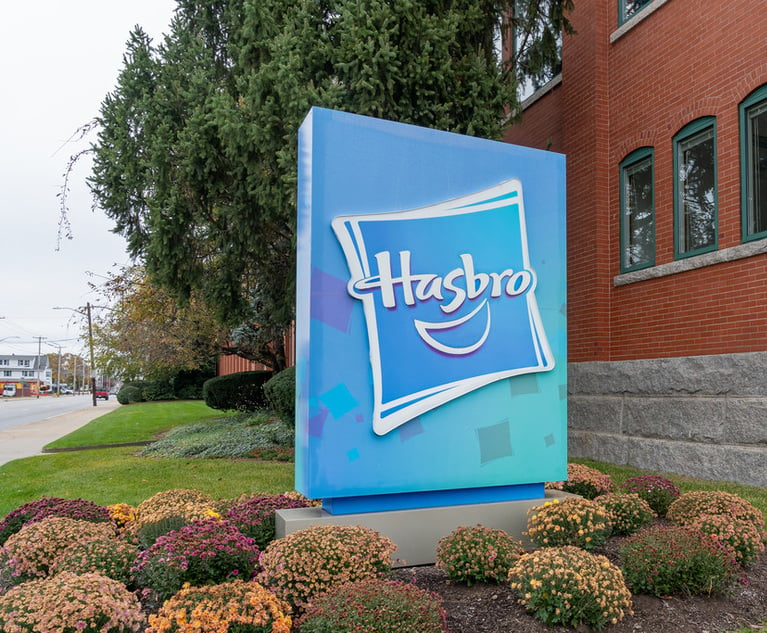Litigation: Trademark licensor liability in product-liability cases
With the U.S. Supreme Court holding last year in Pliva, Inc. v. Mensing that the manufacturer of a generic pharmaceutical product cannot be liable under a failure-to-warn theory, pharmaceutical plaintiffs are searching for new theories to hold nonmanufacturers liable for alleged injuries.
October 18, 2012 at 03:30 AM
3 minute read
The original version of this story was published on Law.com
With the U.S. Supreme Court holding last year in Pliva, Inc. v. Mensing that the manufacturer of a generic pharmaceutical product cannot be liable under a failure-to-warn theory, pharmaceutical plaintiffs are searching for new theories to hold nonmanufacturers liable for alleged injuries. The 2009 case Conte v. Wyeth Inc., et al. was widely publicized for allowing plaintiffs injured by a generic pharmaceutical to hold the “innovator,” or brand-name manufacturer, liable even though it did not manufacture the product, but Conte has not found favor with other courts. In the wake of Mensing and Conte's failure to gain traction, one has to wonder which nonmanufacturer is the next target.
Plaintiffs recently scored a victory in the battle to hold trademark and trade name licensors liable in product-liability actions in August when the Connecticut Superior Court in Aquaulo ex. rel. Saldibar, et al. v. A.O. Smith Corp., et al. affirmed a $2.4 million verdict against a trademark licensor that neither sold nor manufactured the asbestos-containing dry-set ceramic tile mortar at issue. Although claims against trademark or trade name licensors have had mixed success, licensors should examine their relationship with the license-holding manufacturers or sellers and determine if the benefits of the license are worth the potential risk of liability.
Saldibar and preceding cases rely on the degree of control maintained over the product by a licensor and the extent of the licensor's involvement in the distribution, marketing or manufacture of the product. In Saldibar, the defendant, a trade association that developed and patented asbestos-containing formulas for the mortar it licensed to manufacturers, moved for summary judgment on the premise that it was not a “product seller” for purposes of Connecticut's Products Liability Act. Summary judgment was denied in favor of allowing the jury to determine whether the defendant held itself out as a manufacturer because it provided licensees with detailed specifications “governing all aspects of the product,” including the percentage of asbestos to be used, the grade of asbestos to use and the supplier from whom the asbestos should be purchased; required periodic in-house testing of each licensees' product; marketed the product with its trademark and trademark number prominently featured; collected licensing fees; and issued product warnings.
The Saldibar court cited two earlier cases evaluating the extent of the trademark licensor's participation in the production, marketing or distribution of the product at issue. In the 1990 case Burkert v. Petrol Plus of Naugatuck, Inc., General Motors, the trademark licensor of formulations of automatic transmission fluids, was not deemed a “product seller.” GM exercised no control over the formulations its licensees used, was unaware of the composition of licensees' formulations, received no financial benefits from licensing, had little supervision of the production and distribution of the product, examined no samples or test data, and offered no warnings. Likewise, in Iragorri v. United Technologies Corp., vacated in part on other grounds, Otis Elevator, a trademark licensor, was not considered a “seller of the product” based on a lack of evidence of its control, distribution or marketing of the elevator.
The outcome of a product-liability lawsuit against a licensor may vary widely from state to state, but at a minimum, trademark licensors should give careful consideration to their involvement in the design, manufacturing, marketing and distribution of the products they license. The risk of liability and the possible increase in lawsuits against licensors suggest that, under some circumstances, the risks may outweigh a licensor's benefits.
This content has been archived. It is available through our partners, LexisNexis® and Bloomberg Law.
To view this content, please continue to their sites.
Not a Lexis Subscriber?
Subscribe Now
Not a Bloomberg Law Subscriber?
Subscribe Now
NOT FOR REPRINT
© 2025 ALM Global, LLC, All Rights Reserved. Request academic re-use from www.copyright.com. All other uses, submit a request to [email protected]. For more information visit Asset & Logo Licensing.
You Might Like
View All
Recent Controversial Decision and Insurance Law May Mitigate Exposure for Companies Subject to False Claims Act Lawsuits
7 minute read

Trending Stories
- 1Parties’ Reservation of Rights Defeats Attempt to Enforce Settlement in Principle
- 2ACC CLO Survey Waves Warning Flags for Boards
- 3States Accuse Trump of Thwarting Court's Funding Restoration Order
- 4Microsoft Becomes Latest Tech Company to Face Claims of Stealing Marketing Commissions From Influencers
- 5Coral Gables Attorney Busted for Stalking Lawyer
Who Got The Work
J. Brugh Lower of Gibbons has entered an appearance for industrial equipment supplier Devco Corporation in a pending trademark infringement lawsuit. The suit, accusing the defendant of selling knock-off Graco products, was filed Dec. 18 in New Jersey District Court by Rivkin Radler on behalf of Graco Inc. and Graco Minnesota. The case, assigned to U.S. District Judge Zahid N. Quraishi, is 3:24-cv-11294, Graco Inc. et al v. Devco Corporation.
Who Got The Work
Rebecca Maller-Stein and Kent A. Yalowitz of Arnold & Porter Kaye Scholer have entered their appearances for Hanaco Venture Capital and its executives, Lior Prosor and David Frankel, in a pending securities lawsuit. The action, filed on Dec. 24 in New York Southern District Court by Zell, Aron & Co. on behalf of Goldeneye Advisors, accuses the defendants of negligently and fraudulently managing the plaintiff's $1 million investment. The case, assigned to U.S. District Judge Vernon S. Broderick, is 1:24-cv-09918, Goldeneye Advisors, LLC v. Hanaco Venture Capital, Ltd. et al.
Who Got The Work
Attorneys from A&O Shearman has stepped in as defense counsel for Toronto-Dominion Bank and other defendants in a pending securities class action. The suit, filed Dec. 11 in New York Southern District Court by Bleichmar Fonti & Auld, accuses the defendants of concealing the bank's 'pervasive' deficiencies in regards to its compliance with the Bank Secrecy Act and the quality of its anti-money laundering controls. The case, assigned to U.S. District Judge Arun Subramanian, is 1:24-cv-09445, Gonzalez v. The Toronto-Dominion Bank et al.
Who Got The Work
Crown Castle International, a Pennsylvania company providing shared communications infrastructure, has turned to Luke D. Wolf of Gordon Rees Scully Mansukhani to fend off a pending breach-of-contract lawsuit. The court action, filed Nov. 25 in Michigan Eastern District Court by Hooper Hathaway PC on behalf of The Town Residences LLC, accuses Crown Castle of failing to transfer approximately $30,000 in utility payments from T-Mobile in breach of a roof-top lease and assignment agreement. The case, assigned to U.S. District Judge Susan K. Declercq, is 2:24-cv-13131, The Town Residences LLC v. T-Mobile US, Inc. et al.
Who Got The Work
Wilfred P. Coronato and Daniel M. Schwartz of McCarter & English have stepped in as defense counsel to Electrolux Home Products Inc. in a pending product liability lawsuit. The court action, filed Nov. 26 in New York Eastern District Court by Poulos Lopiccolo PC and Nagel Rice LLP on behalf of David Stern, alleges that the defendant's refrigerators’ drawers and shelving repeatedly break and fall apart within months after purchase. The case, assigned to U.S. District Judge Joan M. Azrack, is 2:24-cv-08204, Stern v. Electrolux Home Products, Inc.
Featured Firms
Law Offices of Gary Martin Hays & Associates, P.C.
(470) 294-1674
Law Offices of Mark E. Salomone
(857) 444-6468
Smith & Hassler
(713) 739-1250






